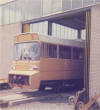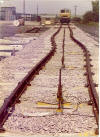



| Although the line was used extensively for APT-E testing in the early 1970's other research work was conducted after the APT-E had gone
-
up to the end of the 1980's. Click on the picture for a bigger image or on the links for more information and pictures - all pictures are the author's unless otherwise credited |
 |
Self -propelled Drewry Car overhead line maintenance vehicle No: RDB998901 in the company of the flat-roofed ex-Ferry Van HSFV4 seen under the dummy OHLE between Widmerpool and Folly Hall curve in the spring of 1980. The OHLE was re-built several times during the High Speed Current Collection Project and the photo shows a 'bridge' section being put in place, note the support arms only just above roof level. |
 |
On 9th September 1982 English Electric Co-Co No: 37 067 stands outside the Control Centre at Old Dalby with a pantograph test train. This consisted of four make-up coaches sandwiched between two laboratory coaches both carrying Brecknell, Willis High Speed pantographs. This was part of a series of runs with different configurations to evaluate various operations with two-pantographs in connection with the proposed HST-E trains. |
 |
The prototype HST 252 001 in shortened form stands at Holwell run round loop, just north of Asfordby Tunnel, about to depart on a northbound test run in the mid-1970's. Judging by the equipment mounted on the front buffer beam it appears to be an aerodynamic test run. The second coach was later to become Lab Coach 'Argus'. (Alan Rimmer) |
 |
The first Leyland Experimental Vehicle (LEV1 - RDB975874) or railbus stands in the workshop at Old Dalby in 1979. For more information about the development of the railbuses which were the forerunners of the class 14x series look here. (Unknown) |
Other Test Work
| After it re-opened as a test track in 1971 the line was used for a large number of tests including the following: ATP -E trials over a period of five years from 1971 to 1976, including the 'POP' train and 'Trestrol', the non-tilting pantograph test vehicle. Track stabilisation trials to test the effectiveness of tamping and track buckling tests were carried out at various times in the early to mid-1970's. Three locos were acquired, two class 35 'Hymeks' and a Class 43 'Warship'. These were diesel hydraulic locos which had been made redundant by the Western Region following the standardisation by BR to diesel electrics. These were used as dead loads and were placed at either side of the buckling point to steady the track. The Warship and one of the Hymeks (D7076) are now preserved - last seen in June 2003 on East Lancs Railway) but D7096 was scrapped some years ago.)
|
 |
A picture of the results of one of the
tests on a
special length of track installed at the rear of the control centre at Old
Dalby. One Hymek is visible in the distance, the other would have been behind
the camera. The poles in the four foot were means of assessing the lateral
movement. I recollect that heat was applied to induce buckling on some testing
but I was not directly involved. Author's collection |
||
 |
The one that didn't survive - D7096 pictured at Old Dalby on 3rd
February 1980 looking
very dilapidated.
Signalman70 |
Another view of the ill-fated D7096 Signalman70 |
|
|
|
The one that did - D7076 pictured on the East Lancs Railway in June 2005 |
 |
Looking a bit worse for wear Warship class 43 No:832 'Onslaught' stands in the yard at the RTC shortly after arrival in March 1973, prior to being despatched to Old Dalby. It was the last of the class to be withdrawn in 1972 and is now preserved and currently on the East Lancs Railway. |
 |
32 years later and 'Onslaught' survives looking resplendent in Maroon livery at the Crewe Works open day on 10th September 2005 | ||
|
Numerous test series have been carried out at the test track during the tenure of the Research & Development Division of the BRB. These included the Stoneblower pneumatic ballast injection machine, the Tubular Axle Induction Motor (TAIM) trials, the hydraulic drive for a DMU (Hydra), various aerodynamic tests, with vehicles stabled in Stanton Tunnel, the cross-braced bogie and crosswind effect tests for the Channel Tunnel, utilising a jet engine mounted at 90º to the track adjacent to 111MP not far from the northern portal of Grimston Tunnel. |
 |
Single car unit No: RDB 975385 (formerly M55997) was converted as a test bed for hydraulic drive in 1980 and was known as Lab 9 'Hydra'. It was tested at Old Dalby on a number of occasions but is pictured here in the RTC yard during in the summer of 1985. For more pictures and information click here. |
|
A number of infrastructure monitoring trains were often seen at Old Dalby during their development and calibration. In the late 1970's the origins of what was to become the Structure Gauging Train were trialled at the test track, as was the High Speed Track Recording Coach. |
 |
The SGT on trial in 1985 pictured at the top of the
Widmerpool straight near Folly Hall. BR Official |

|
The
tribometer adhesion
measurement train (known as the Trib Train) stands outside the compound at Old Dalby in the mid
1970's with the Class 24 'Experiment' at the south end. Colin Marsden |
|
The prototype HST set also spent a number of weeks at the test track and later the power cars served as traction for several types of high speed tests. In 1990 an experiment was undertaken to assess the damage/distortion of soft containers in Channel Tunnel cross flows simulated by a jet engine mounted at right angles to the test track In October 1994 a number of crashworthiness tests were carried out in the vicinity of Widmerpool station DM & EE Tests As well as Research Department tests the line was also used for tests for the DM & EE. Many types of trains have appeared at Old Dalby including Class 89, 90, 91 and 92 electric locos during their pantograph aerodynamic 'tuning' tests and, perhaps most surprisingly, even a Eurostar has been tested there. |
 |
Five Eurostar coaches with their match wagons are
pictured outside the compound at Old Dalby behind a class 47 locomotive in March
1995 whilst undertaking wheelslip tests at the track. Chris Dolman |
|
In the early summer of 1988 the special train destined for the IVA88 exhibition in Hamburg, Germany was brought to the test track. Hauled by a class 47 it performed several brake tests, since the 2-car Sprinter included in the formation was unbraked.A large number of type tests and commissioning trials of the Class 60 heavy haul locos were carried out at Old Dalby over a two year period in the early 1990's. A complete HST set from the Western Region visited Old Dalby in the early 1990's in order to evaluate wheel slip/slide reaction in relation to the Automatic Train Protection system, as did an ATP-fitted class 56 on a heavy train of hoppers. In both of these tests water-spraying equipment was fitted to the traction units to induce wheel spin. The water was laced with soap solution and because of this these sort of tests could not be carried out on the main line. |
|
|
Here is a Brough road-railer being turned on its own table just
to the north of Old Dalby Author's collection |
|
Following the Clapham accident several demonstrations of collision damage with Mk I coaching stock were carried out, using redundant coaches from three class 307 units 307101, 307106 and 307121 some of which featured on the BBC's 'Tomorrow's World' programme. Yes, even Old Dalby was not beyond the reach of Carol Vorderman! Additionally the test track has been used for innumerable lesser tests including braking tests, wheel slip tests, adhesion tests, leaf busting tests, gauging tests, rail grinding trains, ballast tampers, regulators, laser demonstrations, Track Circuit Actuator (TCA) trials, Train Protection & Warning System (TPWS) trials etc., etc. Other People's Tests The line was also used by other organisations for testing. In October 1991 the BREL International coaches returned to Old Dalby for the testing of a novel suspension.
|
|
Specials In the late1980's several special enthusiast's trains traversed the line. The first in March1987 consisted of an eight -car class 115 DMU and a three-car DMU ran in October 1987. Both these trains also visited the Research Division's other test track at Mickleover, near Derby, now closed and lifted, thanks among other things to the motor car. (The final nail in its coffin was the building of the A516 Etwall by-pass in 1990 which crossed the test track.) A final special train ran in September 1989 with a Class 47 hauling a seven-coach train topped and tailed on the test track by 2 x class 20's. On 11th November 2006 Pathfinder Tours ran on the test track what might have been the last train to use the line but as we now know Metronet have taken on the line for future use. |
Back to Main Index